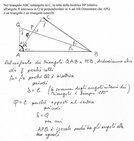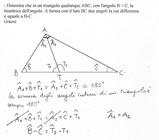Nel triangolo
[math]ABC[/math]
rettangolo in [math]B[/math]
, la bisettrice dell'angolo [math]hat{A}[/math]
interseca [math]BC[/math]
nel punto [math]D[/math]
distante [math]3[/math]
da [math]B[/math]
e [math]5[/math]
da [math]C[/math]
. Sul prolungamento di [math]AD[/math]
si prende dalla parte di [math]D[/math]
il punto [math]E[/math]
distante [math]25[/math]
da [math]C[/math]
Sapendo che la perpendicolare in [math]C[/math]
ad [math]AC[/math]
è bisettrice dell'angolo [math]hat{DCE}[/math]
, determina il perimetro del triangolo [math]CDE[/math]
.
Si pone
[math]\bar{AB}=x[/math]
: essendo [math]\bar{BC}=\bar{BD}+\bar{CD}=3+5=8[/math]
si ha, per il Teorema di Pitagora, che [math]\bar{AC}=\sqrt{64+x^2}[/math]
. E' chiaro ed evidente che i triangoli
[math]ABD[/math]
e [math]ACF[/math]
sono simili e il triangolo [math]CDF[/math]
è isoscele su [math]DF[/math]
, ragione per cui vale la seguente proporzione: [math]\bar{CF} : \bar{BD} = \bar{AC} : \bar{AB}[/math]
. Dalla predetta proporzione segue che
[math]5 : 3 = \sqrt{64 + x^2} : x => 3 \cdot \sqrt{64+x^2}=5x => x=6[/math]
. Dunque, [math]\bar{AB}=6[/math]
e, conseguentemente, [math]\bar{AC}=10[/math]
. Con il Teorema di Pitagora nei triangoli rettangoli [math]ABD[/math]
e [math]ACF[/math]
si trova che [math]\bar{AD}=3\sqrt{5}[/math]
e [math]\bar{AF}=5\sqrt{5}[/math]
: da ciò segue che [math]\bar{DF}=2\sqrt{5}[/math]
. Con il Teorema della bisettrice dell'angolo interno, applicato al triangolo [math]CDE[/math]
si trova che [math]\bar{EF}=10\sqrt{5}[/math]
. Finalmente, [math]2p(CDE)=\bar{CD} + \bar{CE} + \bar{DE}= 5 + 25 + (10\sqrt{5} + 2\sqrt{5})=30 + 12\sqrt{5}[/math]
. FINE









 Accedi a tutti gli appunti
Accedi a tutti gli appunti
 Tutor AI: studia meglio e in meno tempo
Tutor AI: studia meglio e in meno tempo